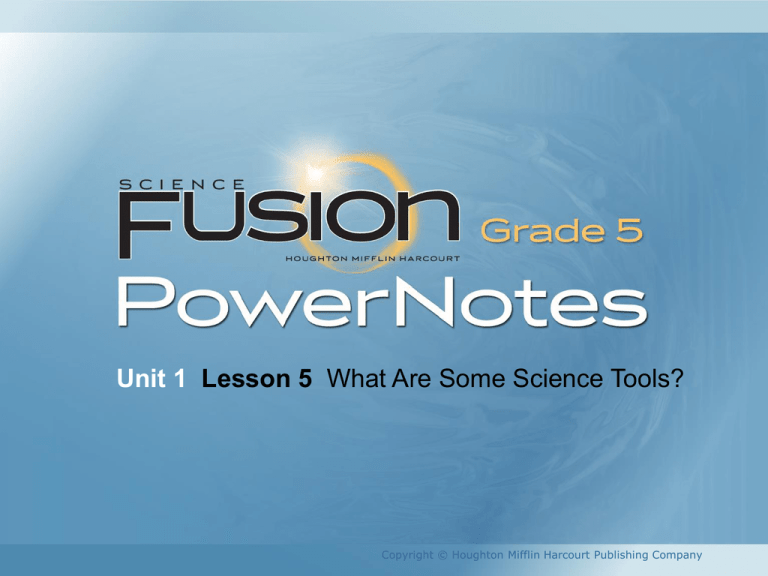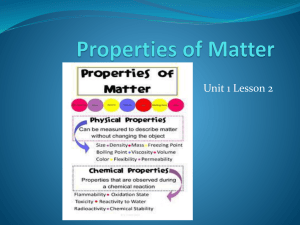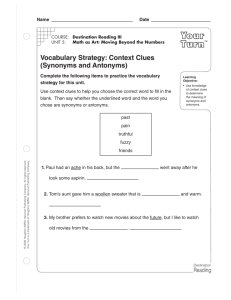Unit 1 Lesson 5
advertisement

Unit 1 Lesson 5 What Are Some Science Tools? Copyright © Houghton Mifflin Harcourt Publishing Company Unit 1 Lesson 5 What Are Some Science Tools? Florida Benchmark • SC.5.N.1.1 Define a problem, use appropriate reference materials to support scientific understanding, plan and carry out scientific investigations of various types such as: systematic observations, experiments requiring the identificiation of variables, collecting and organizing data, interpreting data in charts, tables, and graphics, analyze information, make predictions, and defend conclusions. Copyright © Houghton Mifflin Harcourt Publishing Company Unit 1 Lesson 5 What Are Some Science Tools? Field Trips • Field scientists go “on location” to investigate the natural world. • Field scientists may use tools such as a collecting net, a hand lens, and a camera to complete investigations. Copyright © Houghton Mifflin Harcourt Publishing Company Unit 1 Lesson 5 What Are Some Science Tools? Into the Lab • In the lab, computers and other heavy or expensive instruments can be used to complete investigations. • Some instruments used by scientists in the lab include light microscopes, droppers, electron microscopes, and pipettes. • All scientists must be comfortable using numbers to complete investigations. Copyright © Houghton Mifflin Harcourt Publishing Company Unit 1 Lesson 5 What Are Some Science Tools? Light Microscope • Microscopic things are too small to see with just your eyes. • Light microscopes magnify things, or make them look bigger. • Light passes through objects placed on a glass slide and then through lenses. An eyepiece magnifies the object. Copyright © Houghton Mifflin Harcourt Publishing Company Unit 1 Lesson 5 What Are Some Science Tools? Dropper • A dropper is a tube with a rubber bulb on one end. • Liquids can be sucked up the tube and dropped out of the tube by squeezing and releasing the bulb. Copyright © Houghton Mifflin Harcourt Publishing Company Unit 1 Lesson 5 What Are Some Science Tools? Electron Microscope • A scanning electron microscope (SEM) can magnify an object up to 1 million times. • The SEM shoots a beam of electrons at the object. • A computer screen shows the surface of the object. Copyright © Houghton Mifflin Harcourt Publishing Company Unit 1 Lesson 5 What Are Some Science Tools? Pipette • Pipettes are similar to droppers, but more exact. • Markings on a pipette can help a scientist to measure the volume of a liquid. Copyright © Houghton Mifflin Harcourt Publishing Company Unit 1 Lesson 5 What Are Some Science Tools? Measuring Up • When you measure, you make an observation involving numbers and units. • Scientists use International System (SI) units, or the metric system, to make observations involving numbers. • Metric system units are based on multiples of 10. Copyright © Houghton Mifflin Harcourt Publishing Company Unit 1 Lesson 5 What Are Some Science Tools? Measuring Length • Length is the distance between two points. • The base metric unit of length is the meter. • Rulers, metersticks, calipers, and tape measures are tools used to measure length. Copyright © Houghton Mifflin Harcourt Publishing Company Unit 1 Lesson 5 What Are Some Science Tools? Measuring Time • Time describes how long events take. • The base unit of time is the second. • Clocks, stopwatches, timers, and calendars are some of the tools used to measure time. Copyright © Houghton Mifflin Harcourt Publishing Company Unit 1 Lesson 5 What Are Some Science Tools? Measuring Temperature • Temperature describes how hot or cold something is. • Scientists measure temperature in degrees Celsius. • Another unit used to measure temperature is degrees Fahrenheit. Copyright © Houghton Mifflin Harcourt Publishing Company Unit 1 Lesson 5 What Are Some Science Tools? Pan Balance • Mass is the amount of matter in an object. The base unit of mass is the kilogram. • A tool used to measure mass is called a balance. An example of a balance is a pan balance. Copyright © Houghton Mifflin Harcourt Publishing Company Unit 1 Lesson 5 What Are Some Science Tools? Pan Balance • A triple-beam balance is more exact than a pan balance. • An electronic balance calculates the mass of an object and displays the results on a screen. Copyright © Houghton Mifflin Harcourt Publishing Company Unit 1 Lesson 5 What Are Some Science Tools? How Strong? • A force is a push or a pull. • Scientists use a spring scale to measure force. • The base unit of force is called a newton. Copyright © Houghton Mifflin Harcourt Publishing Company Unit 1 Lesson 5 What Are Some Science Tools? More Measuring Units of Volume • Volume is the amount of space a solid, liquid, or gas takes up. • The base metric units for measuring volume are the cubic meter and the liter. Copyright © Houghton Mifflin Harcourt Publishing Company Unit 1 Lesson 5 What Are Some Science Tools? Finding Volume • Multiplying the length times width times height of a rectangular object will give the volume of that object. • Liquid volume can be measured using a measuring cup, beaker, or graduated cylinder. Copyright © Houghton Mifflin Harcourt Publishing Company Unit 1 Lesson 5 What Are Some Science Tools? Finding Volume • One cubic centimeter (cm3) is equal to about one milliliter (mL). Copyright © Houghton Mifflin Harcourt Publishing Company Unit 1 Lesson 5 What Are Some Science Tools? Finding Volume • You can find the volume of an irregular solid by dropping it into a graduated cylinder that contains liquid. • Record the volume of liquid before inserting the object. Then, record the volume after inserting the object. • The volume of the object is equal to the final liquid volume minus the starting liquid volume. Copyright © Houghton Mifflin Harcourt Publishing Company Unit 1 Lesson 5 What Are Some Science Tools? Finding Volume • Liquids form a meniscus, or curve, in a glass graduated cylinder. • Always measure liquids from the center of the meniscus. Copyright © Houghton Mifflin Harcourt Publishing Company Unit 1 Lesson 5 What Are Some Science Tools? Accurate Measurements • When a measurement is close to the true size, it is accurate. • There are many things you can do to make your measurements more accurate. Copyright © Houghton Mifflin Harcourt Publishing Company Unit 1 Lesson 5 What Are Some Science Tools? Accurate Measurements • Handle each tool properly. • Use each tool the same way every time. • Measure to the smallest place value the tool allows. • Measure twice. • Record your measurements carefully. Copyright © Houghton Mifflin Harcourt Publishing Company


